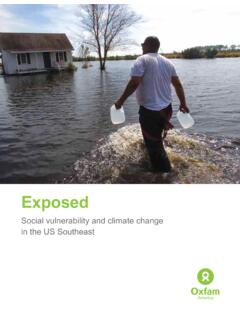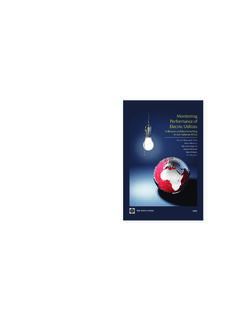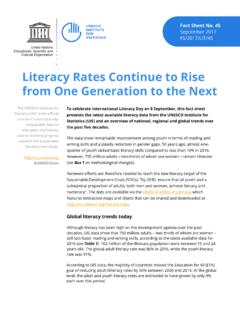Transcription of The energy challenge in sub-Saharan Africa: A guide for ...
1 OXFAM. RESEARCH BACKGROUNDER. The energy challenge in sub- saharan africa : A guide for advocates and policy makers Part 2: Addressing energy poverty James Morrissey 2017. CONTENTS. Oxfam's Research Backgrounders ..3. Author information and acknowledgments ..3. Citations of this paper ..4. Acronyms and abbreviations ..5. Executive summary ..6. 1. Introduction ..11. How to read this report ..14. 2. energy poverty and energy access ..15. energy poverty as the energy use of the poor ..15. energy poverty as deprivation ..16. The impacts of energy poverty ..17. energy access ..20. 3. Expanding access to electricity ..23. Expanding the grid ..26. Mini-grids ..30. Solar home systems (SHSs) ..41. Solar appliances ..44. 4. Electricity and energy poverty ..45. Impacts on household energy poverty ..45. Impacts on economic development ..47. Impacts on services.
2 48. 5. Beyond electricity: Thinking more broadly about energy access ..50. Understanding fuel choices ..50. The impacts of household income and fuel price on fuel The role for improved cookstoves ..53. Liquid petroleum gas (LPG) ..55. 6. Debates and issues concerning energy access ..58. Grid expansion versus distributed technologies ..58. Last-mile connections ..61. Tariffs and Electricity for development or Electricity and development ..71. Modern versus traditional fuels ..73. Financing ..77. 1 Addressing energy poverty 7. Conclusions and ways forward ..80. Focus on the financing ..80. Focus on institutions ..81. Do not neglect traditional fuels ..82. Address uncertainty around grid expansion ..84. Mix technologies for Support the whole distributed energy supply chain (not just up-front costs) ..86. Place electricity access within the broader context of development.
3 86. References ..88. Research Backgrounders Series Listing ..99. Oxfam Research Backgrounder 2. OXFAM'S. RESEARCH BACKGROUNDERS. Series editor: Kimberly Pfeifer Oxfam's Research Backgrounders are designed to inform and foster discussion about topics critical to poverty reduction. The series explores a range of issues on which Oxfam works all within the broader context of international development and humanitarian relief. The series was designed to share Oxfam's rich research with a wide audience in hopes of fostering thoughtful debate and discussion. All Backgrounders are available as downloadable PDFs on our website, , and may be distributed and cited with proper attribution (please see following page). Topics of Oxfam's Research Backgrounders are selected to support Oxfam's development objectives or key aspects of our policy work. Each Backgrounder represents an initial effort by Oxfam to inform the strategic development of our work, and each is either a literature synthesis or original research, conducted or commissioned by Oxfam America.
4 All Backgrounders have undergone peer review. Oxfam's Research Backgrounders are not intended as advocacy or campaign tools; nor do they constitute an expression of Oxfam policy. The views expressed are those of the authors not necessarily those of Oxfam. Nonetheless, we believe this research constitutes a useful body of work for all readers interested in poverty reduction. For a full list of available Backgrounders, please see the Research Backgrounder Series Listing section of this report. Author information and acknowledgments James Morrissey is a researcher at Oxfam America who works on issues of energy , climate, and extractive industries. This work was generously funded by the Nathan Cummings Foundation. The report benefited greatly from the comments and inputs of Sasanka Thilakasiri, Thomas Damassa, Nkiruka Avilla, Daniel Kammen, Subhes Bhattacharyya, Vijay Modi, John McGrath, Gawain Kripke, Heather Coleman, and Kimberly Pfeifer.
5 3 Addressing energy poverty Citations of this paper Please use the following format when citing this paper: Morrissey, James, The energy challenge in sub- saharan africa : A guide for advocates and policy makers: Part 2: Addressing energy poverty Oxfam Research Backgrounder series (2017): For permission to publish a larger excerpt, please email your request to Oxfam Research Backgrounder 4. ACRONYMS AND. ABBREVIATIONS. ICT information and communication technology IEA International energy Agency LCOE levelized cost of electricity LPG liquid petroleum gas PV photovoltaic SHS solar home system UNDP United Nations Development Programme WHO World Health Organization ANC African National Congress 5 Addressing energy poverty EXECUTIVE SUMMARY. energy poverty is a stark problem in sub- saharan africa . Currently 633 million people are estimated to lack access to electricity, and 792 million people are forced to cook with traditional biomass on unimproved cookstoves.
6 While efforts at electrification are expected to bring down the number of people who do not have access to electricity, the number of people using unimproved cooking facilities is expected to increase through 2030. energy -poor households suffer from a wide range of impacts, from increased risk of premature death due to indoor pollution to forgone productivity gains and lower quality of life. On top of these impacts, energy -poor households must spend a greater proportion of their income to meet their basic energy needs. They also spend more time engaging in energy -intensive tasks than do wealthier households who have access to modern energy sources. Past efforts to address energy poverty have focused on promoting energy access. Historically these efforts have centered on providing people with electricity, resulting in a binary measure of energy poverty in which people are either connected or not connected.
7 More recent research has shed light on the complex ways in which households use energy , showing that it is determined by a variety of factors, including the affordability, reliability, and quality of the energy sources available. The result has been an evolution toward a tiered measure of energy access. Overall energy access is hypothesized to offer significant benefits, providing access to services (such as street lighting and schools), improving welfare, driving better health and environmental outcomes, and promoting economic development. This report forms the second of a two-part series. It is an effort to explore the technological opportunities for addressing energy poverty, as well as the policy challenges involved in promoting and deploying these technologies. The first report deals with questions regarding the role of fossil fuels in closing the energy gap in sub- saharan africa .
8 Overall this series finds that addressing energy poverty will require a mix of technologies. Within these, there are a number of important areas that policy advocates can focus on as levers to promote effective efforts to address energy poverty. In the policy environment surrounding energy access, a major focus has fallen on providing access to electricity, and recent changes in the price of renewable energy technologies have sparked debate about the best way to do so. Different approaches include the following technologies: 1. Large-scale grids. Expanding the electrical grid is the most established approach to providing access to electricity. Electricity supplied by the grid is Oxfam Research Backgrounder 6. available at the lowest tariffs because the grid offers opportunities to exploit economies of scale. A large-scale grid can also integrate large amounts of renewable energy .
9 Expanding the grid, however, involves high up-front costs, and the ability to take advantage of economies of scale is limited in sub- saharan africa , where populations are dispersed and have limited ability to pay for electricity. Finally, the grid's physical characteristics mean that it operates as an almost perfect monopoly and as such is best managed as a regulated utility. In sub- saharan africa , where regulation is often weak, utilities have performed notoriously poorly. 2. Mini-grids. Although mini-grids involve lower up-front costs than expanding the grid on a large scale, they are still capable of supplying electricity in quantities that can match the services supplied by the grid. However, the current high cost of renewable components and battery storage means that electricity from mini-grids tends to be more expensive than that provided by the grid.
10 Notably, future reductions in the cost of renewable components and storage are not expected to fully close this gap. This challenge is particularly significant given the low incomes of energy -poor households. In addition, although the up-front costs of mini-grids are lower than grid expansion, they are still high compared with the incomes of local entrepreneurs - who might be expected to finance and run such grids. There are a variety of ways to address the high costs of electricity from mini-grids, but they all require the creation of bespoke energy systems, which limit the technology's ability to be deployed for mass electrification. This challenge is exacerbated by the current lack of technically trained personnel in sub- saharan africa who could design and maintain such energy systems. 3. Solar home systems (SHSs). SHSs can supply electricity to isolated households that are too dispersed to be connected through mini-grids.









